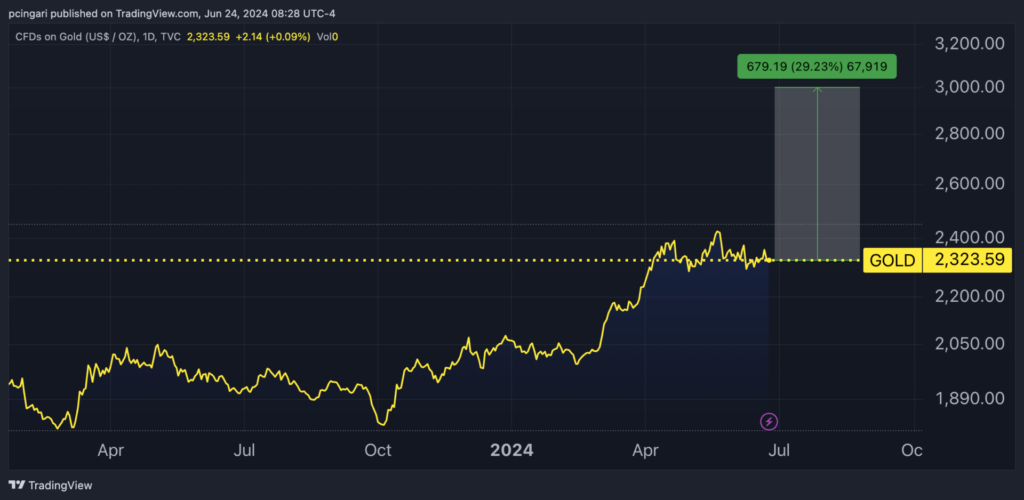Bank of America predicts that gold prices could surge to $3,000 per ounce in the next 12 to 18 months, driven by a combination of key factors.
Michael Widmer, a commodity strategist at the bank, highlights the increasing investment demand, geopolitical tensions, Federal Reserve rate cuts, and central bank purchases as factors that could enhance gold’s appeal to investors.
Resurgence In Investor Demand
2023 witnessed a resurgence in investor interest in gold, with private bar hoarding and central bank acquisitions playing a significant role in purchases, according to Bank of America.
Despite this, physically backed ETFs like the SPDR Gold Trust (NYSE:GLD) have seen a decline in assets under management, which has tempered overall demand growth.
Michael Widmer suggested that an increase in LBMA clearing volumes would signal rising non-commercial demand for gold, aligning with the higher prices needed to balance the market.
Chart: Bank of America Eyes A Near 30% Rally In Gold Prices Within 12-18 Months

Central Bank Purchases As A Key Driver
Central bank purchases continue to play a vital role in supporting gold prices, as indicated by the World Gold Council’s Central Bank Survey.
In 2023, central banks added 1,037 tonnes of gold to their reserves, marking the second-highest annual purchase on record. The survey also reveals a growing intention among central banks to increase their gold reserves in the coming year.
Furthermore, with 83% of central banks holding gold as part of their international reserves, the metal’s role as a long-term store of value and inflation hedge remains prevalent.
China’s Strategic Shift: Sell USD, Buy Gold
Michael Widmer pointed out a significant trend where central banks, including the People’s Bank of China (PBoC), are reducing their USD holdings in favor of increasing gold reserves.
China has notably boosted its gold holdings by 8 million ounces since January 2023, indicating a strategic shift in its foreign reserves composition. This shift has been accompanied by a reduction in China’s holdings of U.S. Treasuries.
Impact Of Federal Reserve Policies, Timeless Safe-Haven Appeal
Bank of America’s analysis suggests that a potential Federal Reserve rate cut and dollar weakening in the latter part of 2024 could fuel investor demand for gold and lift prices.
Despite fluctuations in Treasury yields, gold is expected to maintain its safe-haven status, with a strong likelihood of increased flows into the gold market amidst market uncertainties.
The inverse relationship between gold and rates may be evolving, making gold a resilient asset even in changing economic landscapes.
Now Read: Nasdaq Futures Slip As Nvidia Sell-Off Continues, S&P 500 Futures Hold Up: Analyst Says ‘Valuations Will Go Parabolic And It Will Be A Perfect Time To Sell
Additional Insight:
Gold has historically been viewed as a safe-haven asset, especially in times of economic uncertainty and geopolitical tensions. The increasing interest from both institutional investors and central banks underscores gold’s enduring appeal as a store of value. With ongoing shifts in global monetary policies and geopolitical dynamics, gold may continue to play a crucial role in diversified investment portfolios. Investors should closely monitor evolving trends in gold demand and supply to capitalize on potential price movements in the precious metal market.









